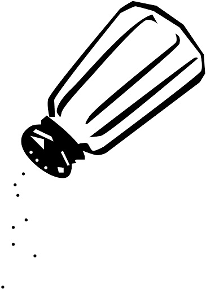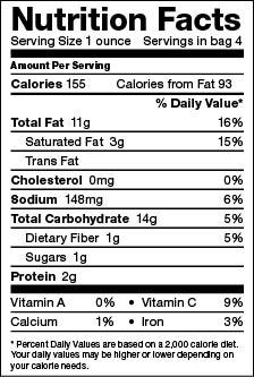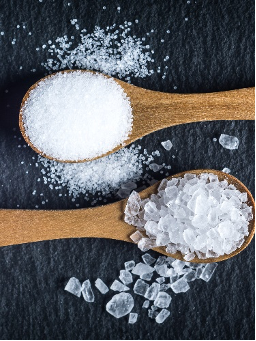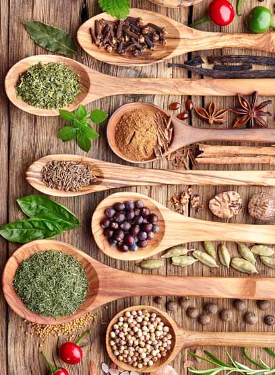 Written by UConn Dietetics Masters student Chris Blancarte
Written by UConn Dietetics Masters student Chris Blancarte
Salt is a chef’s friend. It is the most universally used seasoning in kitchens everywhere because it occurs naturally. It has been used for millennia to preserve food and enhance flavor 1. It is a mineral essential in our diets for the proper functioning of our bodies – but too much of it can be detrimental. In people whose bodies are sensitive to salt, eating too much of it can raise blood pressure, leading to a condition known as hypertension, and creating a risk for heart disease over time. The goal, then, is not to eliminate salt from the diet, but to make sure we are not eating too much of it on a daily basis. Here are some tips to help you be aware!
1. Read Nutrition Labels
Virtually every food product you buy at the store has a Nutrition Facts Label. It’s a law. The  label shows the amount of sodium that is in the food. Other useful information about the food includes the suggested serving size, calories, fat, protein, carbohydrates, and vitamins and minerals. The general goal for sodium, according to the Dietary Guidelines for Americans, is an intake of under 2,300mg of sodium per day 2.
label shows the amount of sodium that is in the food. Other useful information about the food includes the suggested serving size, calories, fat, protein, carbohydrates, and vitamins and minerals. The general goal for sodium, according to the Dietary Guidelines for Americans, is an intake of under 2,300mg of sodium per day 2.
2. Know Where Salt Hides
This tip goes hand-in-hand with reading the nutrition label, because you will start to see how abundant sodium is in certain types of foods. Foods with the highest sodium content tend to be the pre-packaged type because these are processed foods that have been preserved, for example, cured, smoked, or dried meat like bacon, ham, or beef jerky. One of the biggest offenders is microwavable food found in the freezer aisle – they are ready-to-eat and are filled with salt. Most canned foods also have high sodium, unless they are specified as “no salt added” or “low sodium.”
 3. Use Large-Grained or Flaked Salt When Cooking
3. Use Large-Grained or Flaked Salt When Cooking
Do you ever wonder where the salty flavor goes when you are using that shaker on the meat or vegetables you are cooking? Even though you are adding salt, you are still not tasting it because of how it enters your food instead. Here’s how your tastebuds work: if you put a teaspoon amount of salt on your tongue, it’s going to be unpleasantly salty – this is because that salt is directly making maximum contact with your tastebuds. When your salt is instead “spread out” in your foods, you will need to use more of it to taste the same level of saltiness. Try using larger flaked or salt crystals instead of granular (see image at right) – the large crystal won’t “disappear” into your food, and you can taste the salt on the surface of your meat and vegetables – while consuming less sodium!
4. Use More Herbs and Spices
 Salt is a flavor enhancer – bringing out the most pleasing flavors that foods offer. Using more than just salt in your cooking will allow you to get the most out of your meal, and be satisfied with less sodium. Give it a try! If you are used to a significant amount of salt, it will take a little time to get used to less salt. Fresh or dry herbs and spices can make a real difference in your dishes! You may notice you taste those first instead of the salt! Some very flavorful and common varieties of herbs used in cooking are rosemary, basil thyme, dill, cilantro, dried bay leaf and oregano. Some tasty spices are cumin, chili powder, ground ginger, onion powder, garlic powder, turmeric, and pepper. Mix and match to find your favorite ways to season your foods. You may find you need less salt!
Salt is a flavor enhancer – bringing out the most pleasing flavors that foods offer. Using more than just salt in your cooking will allow you to get the most out of your meal, and be satisfied with less sodium. Give it a try! If you are used to a significant amount of salt, it will take a little time to get used to less salt. Fresh or dry herbs and spices can make a real difference in your dishes! You may notice you taste those first instead of the salt! Some very flavorful and common varieties of herbs used in cooking are rosemary, basil thyme, dill, cilantro, dried bay leaf and oregano. Some tasty spices are cumin, chili powder, ground ginger, onion powder, garlic powder, turmeric, and pepper. Mix and match to find your favorite ways to season your foods. You may find you need less salt!
5. Taste as You Go
 The simplest tips are often the most overlooked! Get in the habit of taste-testing your food(s) before you salt and decide if the food even needs any salt. If you know you want salt – go ahead and add some, but a little at a time, from the shaker at the table. This not only will help you control your sodium intake, but it is a great method to keep from ruining any dish by over-salting.
The simplest tips are often the most overlooked! Get in the habit of taste-testing your food(s) before you salt and decide if the food even needs any salt. If you know you want salt – go ahead and add some, but a little at a time, from the shaker at the table. This not only will help you control your sodium intake, but it is a great method to keep from ruining any dish by over-salting.
Happy Cooking!
Citations:
- https://www.history.com/news/off-the-spice-rack-the-story-of-salt
- https://www.cdc.gov/salt/pdfs/sodium_dietary_guidelines.pdf
This material is funded by UDSA’s Supplemental Nutrition Assistance Program (SNAP).
This institution is an equal opportunity employer